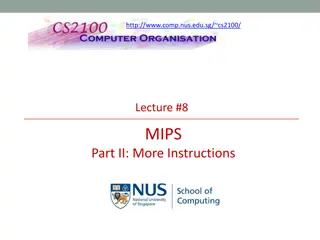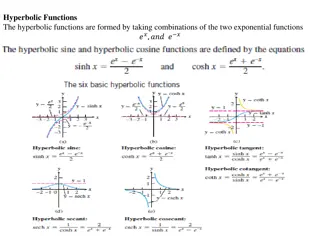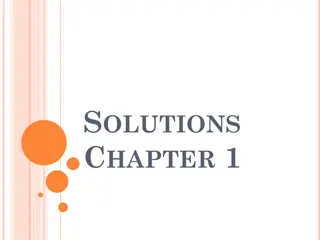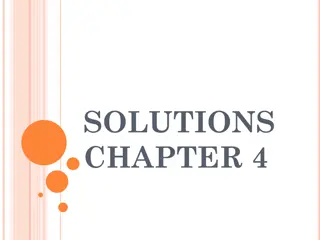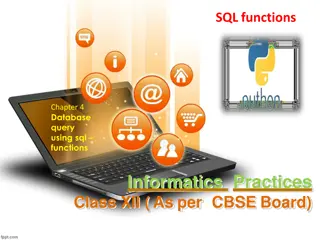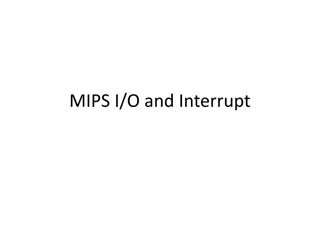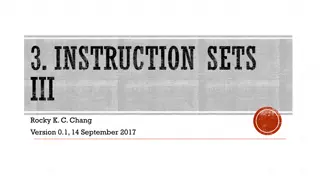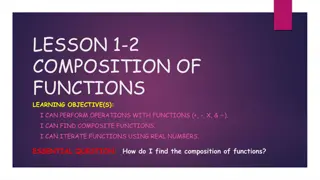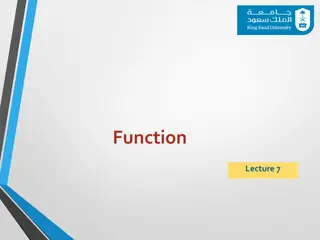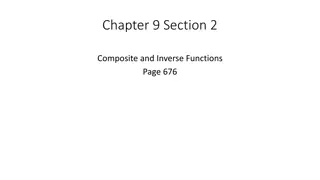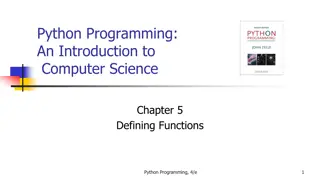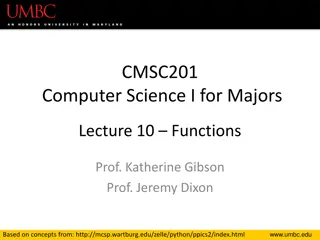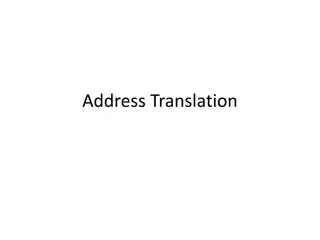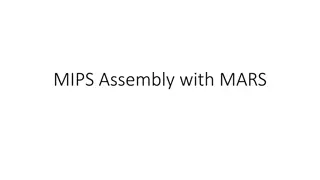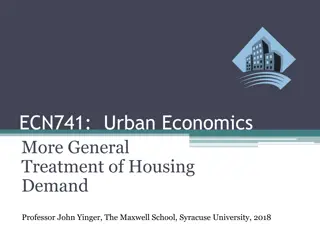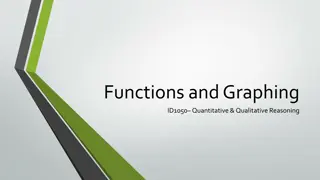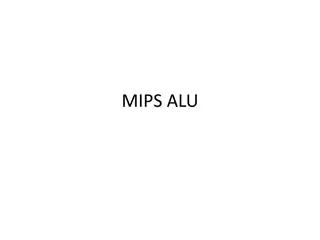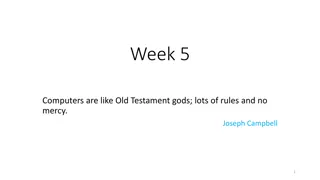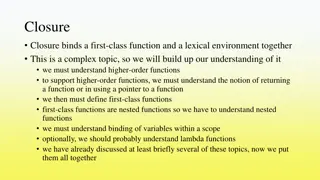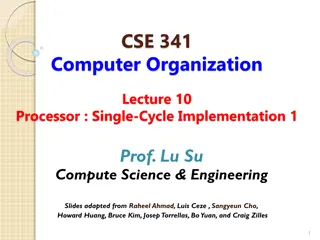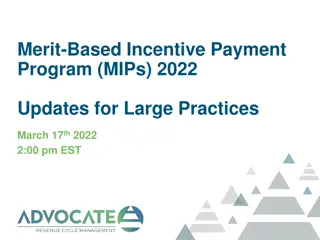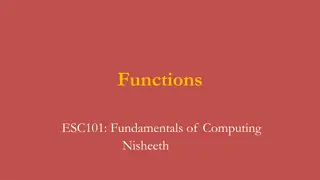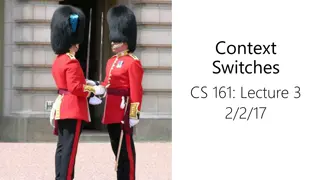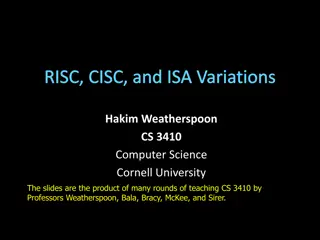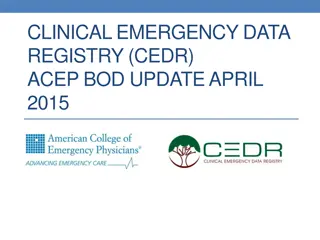MIPS Part II: Memory Organization and Instructions
Explore the intricacies of Memory Organization in the context of MIPS architecture, covering topics such as Memory Transfer Unit, Word Alignment, Load and Store Instructions, Making Decisions with Conditional Branching and Unconditional Jumps, Loops, Arrays and practical exercises. Learn about the m
16 views • 43 slides
MIPS CPU Design Using Verilog and Instruction Set Architecture Overview
Explore the world of MIPS CPU design using Verilog with a deep dive into Instruction Set Architecture (ISA), SPIM instruction formats, addressing modes, and more. Learn about the key components such as Program Counter (PC), Instruction Memory (IM), Register Files (RF), Arithmetic Logic Unit (ALU), D
1 views • 29 slides
Livestock Marketing Functions and Classification
Livestock marketing involves various functions such as exchange, physical supply, facilitative functions like grading, transportation, storage, and more. These functions are classified into primary, secondary, and tertiary functions based on their roles. Assembling, processing, distribution, and equ
3 views • 23 slides
Domain and Range of Functions
Understanding functions involves exploring concepts such as domain, range, and algebraic inputs. This content covers topics like constructing functions, common functions like quadratic and trigonometric, and solving functions based on given domain and range. It also provides practice questions to te
1 views • 21 slides
Overview of MIPS Arithmetic and Logic Instructions in COE 301
MIPS Architecture consists of R-Type and I-Type instruction formats for arithmetic, logical, shift, and immediate constant operations. It includes a variety of general-purpose registers and specific units for execution, floating-point operations, and memory handling. The presentation outlines the st
2 views • 29 slides
Activation Records and Stack in Assembly Programming
Explore the key concepts of activation records and the stack in assembly programming, including their roles in function calls, memory management, and variable storage. Gain insights into the low-level layout of variables, call conventions in MIPS and x86, and practical examples illustrating stack op
2 views • 66 slides
Hyperbolic Functions and Their Inverses
This content delves into the world of hyperbolic functions, discussing their formation from exponential functions, identities, derivatives, and inverse hyperbolic functions. The text explores crucial concepts such as hyperbolic trigonometric identities, derivatives of hyperbolic functions, and integ
1 views • 9 slides
Advanced Techniques for Multiplication Performance Improvement
Explore advanced methods to enhance multiplication performance by utilizing shifts and add/subtract operations instead of traditional arithmetic. The solutions provided involve hexadecimal number pairs, demonstrating the best ways to calculate products efficiently. Furthermore, a challenge is presen
2 views • 59 slides
Performance Analysis of Different MIPS Processors
This analysis compares two different implementations (P1 and P2) of the same instruction set based on clock rates, CPI values, peak performances, and execution times on a 3GHz MIPS processor. The performance trade-offs for changes made to an MIPS process are explored using a breakdown of different p
0 views • 42 slides
Functions in Python: Basics and Usage
In this lecture on functions in Python, the focus is on the basics of defining and using functions. The session covers the formal definition of functions, parameters, local and global scopes of variables, return values, and pass-by-value concept. It emphasizes the importance of proper indentation in
4 views • 28 slides
MIPS Single-cycle Datapath Analysis for Instruction SW
Examine the operation of the single-cycle datapath for a specific MIPS instruction "SW.R4,-100(R16)". This analysis covers the instruction word value, register numbers, control signals, and the logic diagram implementation. Dive into details like instruction word encoding, register file operations,
0 views • 55 slides
Functions: Tables, Graphs, and Formulas Based on Functions, Data, and Models
Explore the world of functions through tables, graphs, and formulas in this presentation based on the book "Functions, Data, and Models" by S.P. Gordon and F.S. Gordon. Learn how functions in the real world work, understand the relationship between variables, and see different representations of fun
0 views • 29 slides
SQL Functions for Database Queries
SQL functions are essential elements in performing actions and obtaining results in a database query. They come in two main types: scalar functions and aggregate functions. Scalar functions operate on single values, while aggregate functions operate on sets of data. Examples of SQL functions include
1 views • 14 slides
Managing Multiple Priorities Amidst Chaos - Strategies for Success
Effective strategies for managing multiple priorities include maintaining a structured to-do list system, engaging regularly with Most Important Priorities (MIPs), and implementing weekly and daily tactical plans. Avoiding poorly defined tasks and utilizing external systems for tracking commitments
0 views • 29 slides
Basis Functions and Hemodynamic Response Functions in fMRI Analysis
This content discusses the use of basis functions, parametric modulation, and correlated regressors in the first-level analysis of fMRI data processing. It delves into the concept of temporal basis functions for modeling complex functions of interest, such as the canonical hemodynamic response funct
1 views • 26 slides
Functions in Coding with Minecraft
Functions in coding are self-contained sets of instructions that perform specific tasks within a computer program. They allow for code reuse and save time by writing instructions once as a function and calling it whenever needed. This content covers the purpose of functions, how they save time when
1 views • 30 slides
MIPS I/O and Interrupt Handling
Delve into the world of MIPS architecture, exploring how I/O operations and interrupts are managed. Learn about memory organization, system functions, I/O registers, and kernel data. Discover how SPIM facilitates input and output handling, including reading from the keyboard and managing output. Div
1 views • 18 slides
MIPS Instruction Sets and Binary Execution
This lecture covers the mapping of MIPS instructions to binary for execution, the use of pseudo-instructions to improve code readability, and the handling of large constants. It discusses levels of representation and interpretation, the concept of stored-program computers, addressing in memory, bina
0 views • 50 slides
Composition of Functions in Mathematics
Learn how to perform operations with functions, find composite functions, and iterate functions using real numbers. Explore the composition of functions through examples and understand the domain of composite functions. Enhance your mathematical skills by mastering operations like addition, subtract
0 views • 10 slides
Functions in C Programming
Functions play a vital role in C programming by enabling the execution of specific tasks. They can be pre-defined or user-defined, offering flexibility and efficiency in code organization and execution. Pre-defined functions are already available in C libraries, while user-defined functions are cust
2 views • 46 slides
MIPS Functions and Calling Conventions
MIPS functions in assembly language are called using the 'jal' instruction, passing arguments in specific registers. Functions must end with 'jr $ra' and have explicit declarations. MIPS functions are stored separately from the main function in memory. The 'jal' instruction jumps to a specified addr
1 views • 18 slides
Composite and Inverse Functions
Learn about composite functions, inverse functions, and how to find their compositions and inverses through examples and step-by-step explanations. Explore the concept of forming composite functions, verifying inverse functions, and finding the inverse of a function using interchange and solving met
0 views • 15 slides
Introduction to Defining Functions in Python Programming
This chapter introduces the concept of defining functions in Python programming. It covers the importance of dividing programs into sets of cooperating functions, defining new functions in Python, understanding function calls and parameter passing, and reducing code duplication through the use of fu
0 views • 78 slides
Functions in Computer Science I for Majors Lecture 10
Expanding on the importance of functions in programming, this lecture delves into dividing code into smaller, specific pieces, defining functions in Python, understanding function calls and parameter passing, and using functions to enhance code modularity. Key topics covered include control structur
0 views • 62 slides
Address Translation in Computer Systems
Explore the concept of address translation in computer systems, covering topics such as converting virtual addresses to physical addresses, different translation methods, goals of address translation, bonus features, and a preview of MIPS address translation. Learn about the benefits and limitations
0 views • 60 slides
Introduction to MIPS Assembly Programming with MARS
Introduction to MIPS Assembly Programming with MARS including instructions, I-Type format, register initialization, addi instructions, and translation to machine code using an assembler. Learn how to perform basic arithmetic operations in MIPS assembly language.
0 views • 61 slides
Housing Demand Theory in Urban Economics
Explore the nuances of housing demand theory in urban economics, covering topics such as alternative utility functions, exponential density functions, maximizing bid functions, and comparative statics. Delve into Stone-Geary and CES utility functions, their implications on demand functions, and the
0 views • 35 slides
MACRA and MIPS for Post-Acute Care Providers
Explore the key provisions of MACRA impacting post-acute care (PAC) providers, including the Merit-based Incentive Payment System (MIPS) and Advanced Alternative Payment Models (APMs). Learn about quality reporting requirements, payment structures, and participation options under MACRA to optimize r
0 views • 20 slides
Functions and Graphing in Mathematics
Functions and graphing play a crucial role in quantitative and qualitative reasoning. We explore the concept of points on a graph, coordinates, relations, functions, and ways to express functions. Utilizing visual aids and analogies, we delve into the importance of coordinates, the distinction betwe
0 views • 10 slides
MIPS Arithmetic Logic Unit (ALU)
The MIPS ALU is the heart of computer calculations, performing functions like add, and, or, and sub. This article delves into designing a full ALU, starting from a 1-bit full adder to a 32-bit ALU. It explores how operations like and, or, and addition are carried out within the ALU, and how to imple
0 views • 28 slides
Exception Handling and Interrupts in MIPS Architectures
Exception and interrupts in MIPS play a crucial role in handling unexpected events and external requests efficiently. Exceptions include changes in control flow, arithmetic overflows, and hardware malfunctions, while interrupts are externally caused events like I/O requests. When an exception occurs
2 views • 29 slides
Computer Architecture: Exploring MIPs, Assembly Code, and BIOS Functions
Dive into the world of computer architecture with a focus on MIPs assembly language, basic program formats, BIOS functions, and system calls. Learn about the role of the OS kernel, memory addresses, and control flow in executing programs efficiently.
2 views • 16 slides
Closures, Lambda Functions, and Higher-Order Functions in Programming
In programming, closures bind functions and lexical environments, while lambda functions are nameless and used by higher-order functions. Higher-order functions operate by applying other functions, such as map and fold functions. Example implementations in LISP demonstrate how these concepts are uti
2 views • 16 slides
Overview of Single-Cycle Implementation in Computer Organization
Today's lecture discussed the single-cycle implementation of processors, focusing on executing instructions in hardware based on the ISA. The process involves different cycles such as instruction fetch, decode, execution, memory access, and write-back. The presentation highlighted the functions of a
0 views • 24 slides
Introduction to Python Functions: Overview and Usage
In this module, we delve into Python functions, exploring common built-in functions and how to create custom functions. We learn the properties of functions, how to coordinate multiple functions, and concepts of modularization. Discover the essence of functions in Python programming through practica
0 views • 17 slides
MIPS 2022 Updates and Program Recap for Large Practices
Explore the latest updates for the Merit-Based Incentive Payment Program (MIPs) in 2022, including performance year changes, quality category considerations, penalty mitigation strategies, and historical thresholds. Learn how MIPS rewards clinicians for high-quality, cost-effective care under MACRA.
0 views • 27 slides
Functions in C Programming
Functions play a crucial role in C programming, allowing for modularity and reusability of code. This content covers the basics of functions, creating custom functions, passing arguments, returning values, and the anatomy of a C function. Learn about defining functions, passing arguments effectively
0 views • 24 slides
Context Switching and User-Kernel Interaction in Operating Systems
Context switching in operating systems involves a seamless transition between user-level threads without the kernel's awareness. User-level code manages register state and stack pointers, while user-kernel mode switching requires changing processor privilege levels and agreement on information excha
1 views • 25 slides
Instruction Set Architectures (ISAs) in Computer Science
Explore the concepts of RISC, CISC, and ISA variations in computer architecture. Dive into the differences between MIPS, ARM, X86, and other ISAs, focusing on load/store, arithmetic, control flow, and more. Gain insights into the evolution and variations of ISAs, and discover the alternatives beyond
0 views • 37 slides
Federal Physician Quality Program Evolution 2015-2026
Federal Physician Quality Programs have evolved from 2015 to 2026, impacting Medicare providers through initiatives like MIPS, PQRS, and VM. QCDRs play a significant role in MIPS participation, enabling performance assessment and receiving feedback. Learn about the total impact of participating in t
0 views • 23 slides
